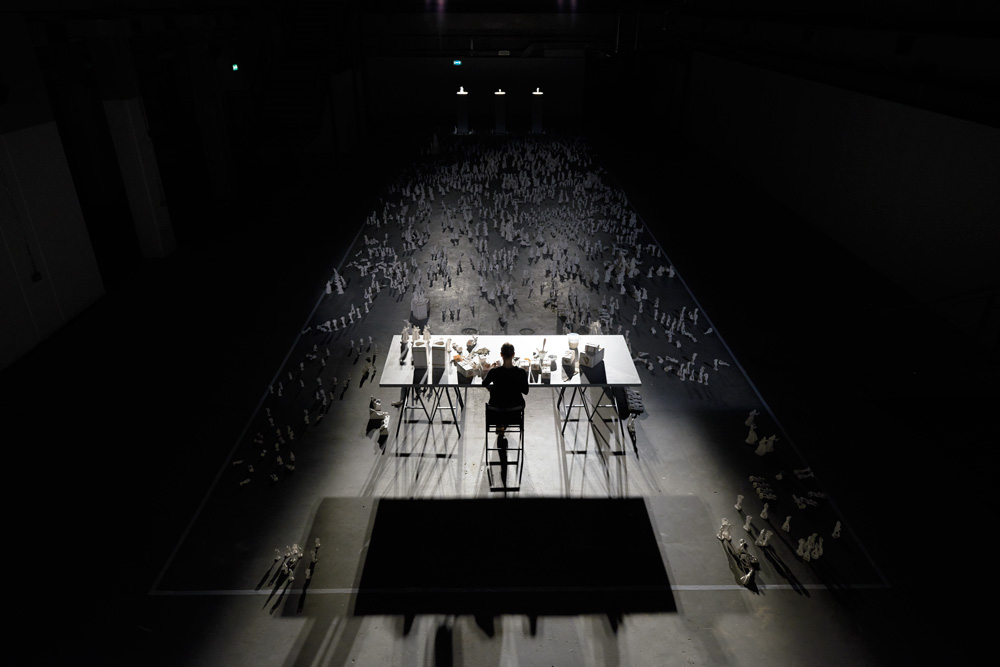Tucked away on the third floor of the Gardiner Museum, British ceramic artist Clare Twomey‘s installation Piece by Piece is a startling world unto itself. (Disclosure: I’m a member of Partners in Art, a presenting sponsor of the installation.)
Walking into Piece by Piece, the impression is of a darkened theatre-in-the-round brightened by four spotlit areas. Three of these lit areas feature delicate, 18th-century harlequin figures on plinths. Directly opposite, a fourth large circle of light brightens a worktable. On the darkened floor between the table and the plinths reside thousands of ghostly figures—small bodies are grouped into tableaux where they march in step, writhe in piles, dance with joy.
Though Piece by Piece alludes to binary opposites such as light and dark, love and war, process and product, the artist ultimately crafts a complex spectrum that reflects the passions and struggles inherent in our own lives. A multitude of other contrasts weave through the work as well.
On the institutional level, there is the legacy of collector and museum co-founder George Gardiner, a man who ran a munitions factory and raced horses—but who also, with his wife Helen, collected incredibly fragile and delicate ceramics such as the harlequins on display in Piece by Piece. In the space of the room itself, the harlequins are placed at the highest point, ideals of perfection.
A human performer named the Maker, meanwhile, sits at the worktable creating figures out of molds based on the three original harlequins. When a copy is finished, the Maker decides on the value of the figure and places it on the spectrum between the worktable, surrounded by broken bodies, all the way to the other end of the scale, by the three plinths of perfection.
One’s eye gets drawn back and forth between the two sides of the room, trying to make sense of the scenes in between. The intriguing and puzzling relationships in the installation hold a viewer’s attention, whether it is being pulled between the perfect, colourful, glazed harlequins and their white copies, between the live Maker and their inanimate objects that create such lively scenes, or between the uncluttered perimeter and the chaos of the centre.
Piece by Piece incorporates aspects of Clare Twomey’s past museum interventions, which have challenged traditional ideas of an exhibition and of an arts institution.
In Consciousness/Conscience (2001–2004), an installation composed of fragile, unfired bone-china floor tiles, destruction becomes key to the creation of the piece—viewers have to walk on, and necessarily break, the tiles to get to other parts of the exhibition, turning notions of “making” upside down.
Monument (2009), exhibited at the Middlesbrough Institute of Modern Art and the Zuiderzee Museum, consists of a massive pile of broken ceramics—a towering monument to imperfection in a space (the museum) devoted to the preservation of perfection.
Piece by Piece likewise includes the broken, the unglazed, the deformed, and the destroyed and sets such elements up to be “onstage” performers. It also suggests the subjective aspects of selection and display, revealing the uncomfortable truths behind ideas of value.
Rather than inserting her works into an existing exhibition gallery, Twomey carefully curates an isolated dance for viewers within an otherwise empty space. Tensions between made and unmade, old and new, dark and light show us that we live life in the space between polar opposites. In this staged performance, the artist questions social and artistic ideals of excellence and class, piece by piece.









